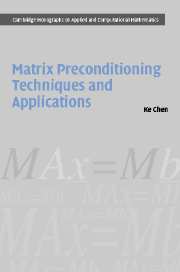Book contents
- Frontmatter
- Contents
- Preface
- Nomenclature
- 1 Introduction
- 2 Direct methods
- 3 Iterative methods
- 4 Matrix splitting preconditioners [T1]: direct approximation of An×n
- 5 Approximate inverse preconditioners [T2]: direct approximation of An×n−1
- 6 Multilevel methods and preconditioners [T3]: coarse grid approximation
- 7 Multilevel recursive Schur complements preconditioners [T4]
- 8 Sparse wavelet preconditioners [T5]: approximation of Ãn×n and Ãn×n−1
- 9 Wavelet Schur preconditioners [T6]
- 10 Implicit wavelet preconditioners [T7]
- 11 Application I: acoustic scattering modelling
- 12 Application II: coupled matrix problems
- 13 Application III: image restoration and inverse problems
- 14 Application IV: voltage stability in electrical power systems
- 15 Parallel computing by examples
- Appendix A a brief guide to linear algebra
- Appendix B the Harwell–Boeing (HB) data format
- Appendix C a brief guide to MATLAB®
- Appendix D list of supplied M-files and programs
- Appendix E list of selected scientific resources on Internet
- References
- Author Index
- Subject Index
- Plate section
15 - Parallel computing by examples
Published online by Cambridge University Press: 06 January 2010
- Frontmatter
- Contents
- Preface
- Nomenclature
- 1 Introduction
- 2 Direct methods
- 3 Iterative methods
- 4 Matrix splitting preconditioners [T1]: direct approximation of An×n
- 5 Approximate inverse preconditioners [T2]: direct approximation of An×n−1
- 6 Multilevel methods and preconditioners [T3]: coarse grid approximation
- 7 Multilevel recursive Schur complements preconditioners [T4]
- 8 Sparse wavelet preconditioners [T5]: approximation of Ãn×n and Ãn×n−1
- 9 Wavelet Schur preconditioners [T6]
- 10 Implicit wavelet preconditioners [T7]
- 11 Application I: acoustic scattering modelling
- 12 Application II: coupled matrix problems
- 13 Application III: image restoration and inverse problems
- 14 Application IV: voltage stability in electrical power systems
- 15 Parallel computing by examples
- Appendix A a brief guide to linear algebra
- Appendix B the Harwell–Boeing (HB) data format
- Appendix C a brief guide to MATLAB®
- Appendix D list of supplied M-files and programs
- Appendix E list of selected scientific resources on Internet
- References
- Author Index
- Subject Index
- Plate section
Summary
Parallelism has sometimes been viewed as a rare and exotic subarea of computing, interesting but of little relevance to the average programmer. A study of trends in applications, computer architecture, and networking shows that this view is no longer tenable. Parallelism is becoming ubiquitous, and parallel computing is becoming central to the programming enterprise.
Ian Foster. Designing and Building Parallel Programs. Addison-Wesley (1995)I rather kill myself than debug a MPI program.
AnonymousParallel computing represents a major research direction for the future and offers the best and often the only solution to large-scale computational problems in today's technology. A book on fast solvers is incomplete without a discussion of this important topic. However, any incomplete description of the subject is of no use and there are already too many books available. Nevertheless, the author believes that too much emphasis has been put from a computer scientist's view (on parallelization) so that a beginner may feel either confused with various warnings and jargons of new phrases or intimated by the complexity of some published programs (algorithms) of well-known methods. Hence we choose to give complete details for a few selected examples that fall into the category of ‘embarrassingly parallelizable’ methods.
Therefore the purpose of this chapter is to convey two simple messages.
- Type
- Chapter
- Information
- Matrix Preconditioning Techniques and Applications , pp. 475 - 503Publisher: Cambridge University PressPrint publication year: 2005

